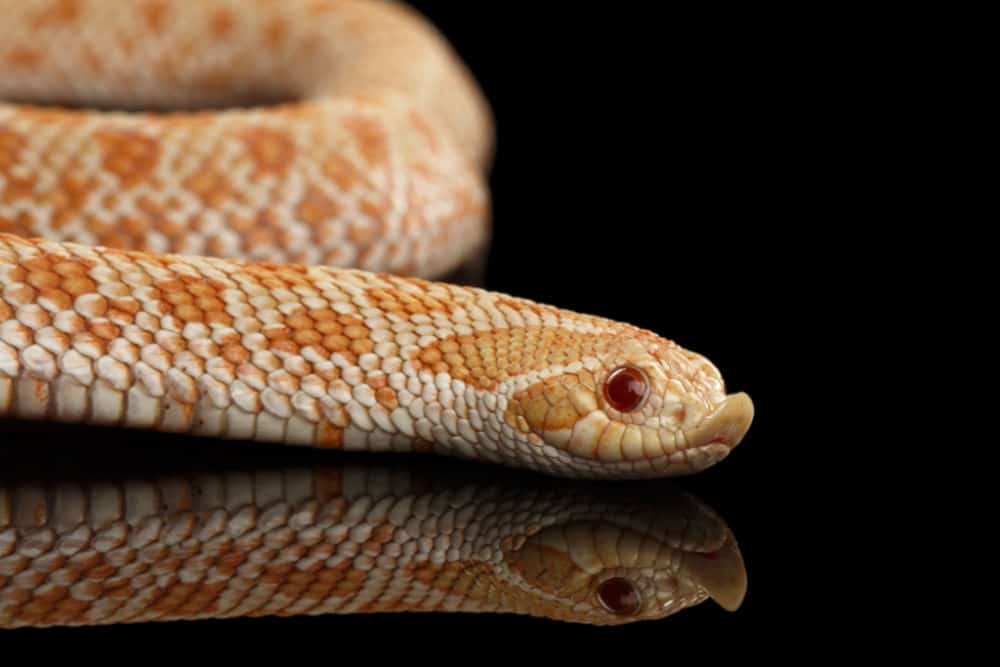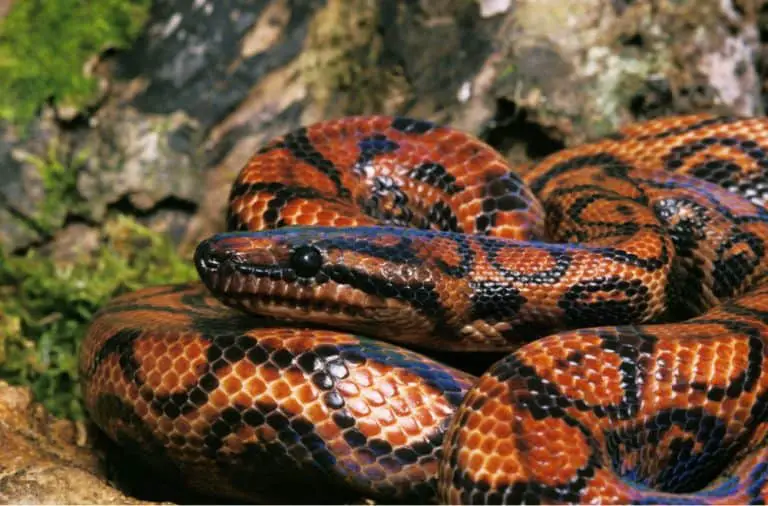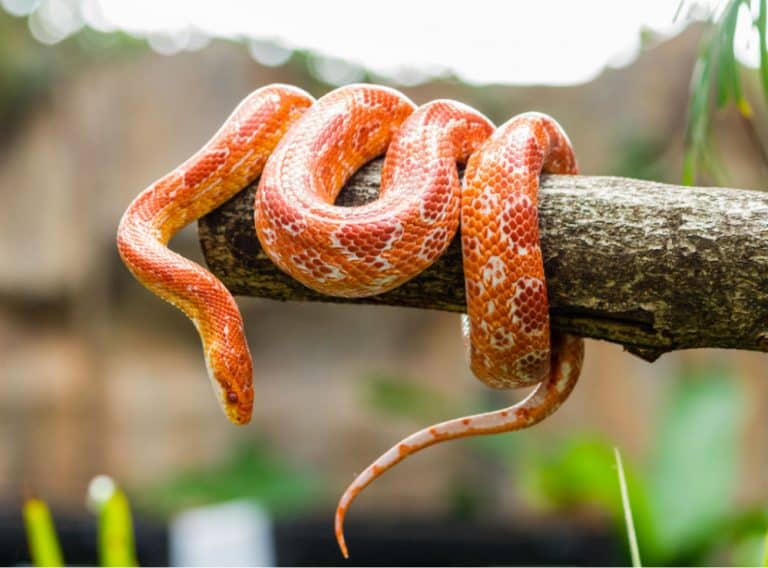Hognose Snake Care Sheet: Diet, Habitat, and More
Hognose snakes are calm, docile pets that have won over the hearts of many snake collectors and people looking for a pet addition. They are a member of the Colubrid family and smaller than the average pet snake, which is around three feet long.
A hognose snake is easy to take care of. It thrives well in a warm tank with plenty of substrates to burrow. It doesn’t require a unique feeding program as you can give it pre-thawed frozen rodents. Additionally, it doesn’t get sick often, although you need to sanitize its environment precisely.
This care sheet offers detailed information on how to care for a hognose snake, including its diet and habitat. So read on.
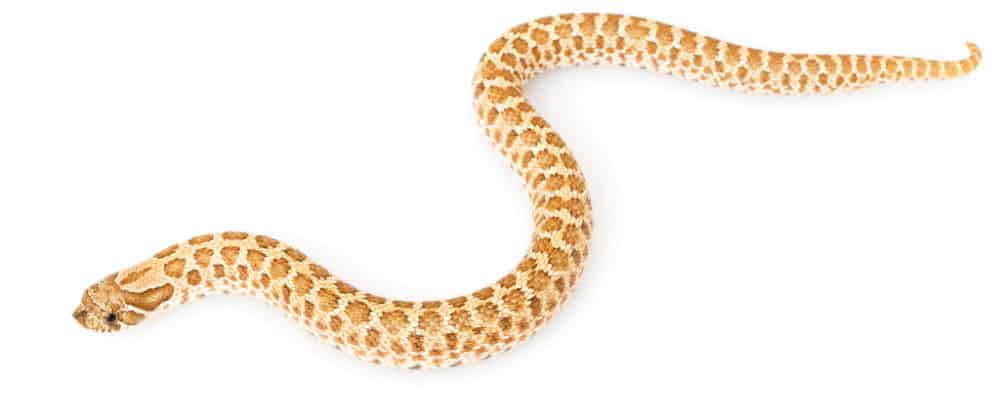
Hognose Habitat
The hognose acquires its name from the upturned appearance of their snout. The species including the western, the eastern and the southern hognose snakes require the same kind of care.
A hognose snake is a ground-dwelling species and requires a spacious enclosure: thus, height is unimportant. Plastic reptile terrariums such as this REPTI ZOO Reptile Glass Terrarium are inexpensive and widely available at most pet stores.
Hognose hatchlings can start in small enclosures like a 5-10 gallon aquarium cage. When they are young, they can be shy but very active. Like all snakes, the hognose is an excellent escape artist; therefore, you need great care when planning out their housing.
Hatchlings can squeeze out of the smallest spots. Ensure that the tank or vivarium includes a tight-fitting lid that you can clamp down to prevent them from getting out.
As the snake grows and reaches one year, you can increase the size of its housing to coincide with its size. An adult male grows approximately 1 foot while females grow to around two feet and weigh twice as much as males. An adult hognose will need a 20-gallon aquarium cage or a 28-32 qt tub. They feel more secure in a suitably sized housing.
Additionally, when you keep multiple adults together, just ensure that you separate them when feeding. It can also be more economical to use large, bright plastic shoes and sweater boxes if hosting a large number of snakes. Ensure that you drill holes in them for adequate ventilation.
The material construction that should feature in a hognose housing can include wood, PVC, melamine, glass, or plastic. Here are the various conditions that a vivarium or tank should contain.
Temperature Settings
Like all reptiles, a hognose is cold-blooded. Therefore, they cannot generate body heat. If you live in cold environs, the western hognose snake may struggle to cope with the atmosphere.
Providing the right heat and lighting conditions is crucial for keeping the snake happy and healthy. Besides, you can keep the hognose in a wooden vivarium in cold weather environments due to the temperature gradient required.
When you keep your hognose in an environment that doesn’t have proper warmth, you risk your pet or worse health problems. Therefore, the housing must feature a cool side and a hot spot where the hognose will thermo-regulate its body temperature.
The colder end of the cage should be around 75-80°F (24-27°C), while the enclosure’s hotter side should be approximately 85-90°F (29.4-32.2°C). Similarly, many snake owners keep a thermometer inside the housing to monitor the temperature.
To regulate temperature for your snake:
- Use an infrared heat gun thermometer, which features a point-and-shoot method, makes an excellent choice, and you can find one in a pet store.
- Basking lights are the most common method for heating the hognose cage. Place a heat lantern on top of the tank for warmth and lighting. Additionally, a heat mat beneath the enclosure works well.
- A heat mat for night usage should not be placed directly under the enclosure unless you keep an eye on the temperature for at least one week before introducing the hognose to the habitat.
- A heating cable and heat tape make an excellent thermostat system in a rack system. The thermostat alerts you by turning on when the temperature is too cold and safely turns the heat off when the cage is warm enough. You don’t need to worry that your snake will overheat or get too cold.
However, you can regularly check the temperature inside the snake’s tank to tell whether the heat pad has gone cold. Besides, an adhesive thermometer placed inside the enclosure will make the task easy.
Ensure that you purchase a high-quality thermostat to control the environment that will keep the snake within the perfect temperature range and put your mind at ease.
A digital laser thermometer is a valuable investment as it features advanced controllers for precision temperature, lighting, and humidity control. It’s an excellent choice for running a reptile facility.
Additionally, a consistent cold environment throughout the habitat will encourage brumation. The reaction results from insufficient heat for normal activities.
Brumation may occur when a heater malfunction occurs and goes unnoticed. Brumation may cause your snake to be sluggish and start to hide or refuse to eat food.
Humidity Settings
The hognose is an extremely sturdy snake and prefers dry conditions. Although in the wild it can cope with reasonably hot conditions, medium to low humidity level is perfectly adequate for the hognose.
For western hognose, keep the humidity range between 30-50 percent and for the southern and eastern hognose snakes between 50-60 percent.
While the hognose’s cage should be kept dry, you can make a humid hide with sphagnum moss or eco earth, which you can mist when needed. The cold spot helps your snake feel secure, especially when shedding. Besides, a female hognose may use the humid hide to lay her eggs.
When the hognose is shedding, it requires humidity levels of 60-65 percent for a couple of days. However, it can be challenging to keep the humidity up in an enclosed cage with a screen top. The best way to achieve this is by using reptile foggers to mist the snake. You can also choose to use a spray bottle to dump the sphagnum moss.
A successful snake keeper knows that temperature and humidity levels are never constant in the snake’s habitat. Therefore, although you may have a hygrometer attached to the side of the cage, you need careful observation when making warm baths. It may create unsanitary conditions favorable for the growth of molds.
Hides
A large enclosure allows you to have additional hiding places that will enable the hognose to keep cover when feeling stressed. You can include a hide on the hot side and the cold front so that the snake can have different options.
Additionally, a large hide is easy to clean and sanitize. However, the hiding place should only accommodate a coiled hognose and not too big that it will not be usable.
You can also include extra items in the enclosure like logs and branches to make a cozy spot for the hognose as you will often see your snake climbing on them. If you decide to keep the snake in a biologically active cage, you can include a nutrient fertile soil and clay mix. We recommend keeping the cage furniture simple.
Also, keep a sturdy, clean water bowl in the snake’s enclosure. It should be dense so that it doesn’t tip over and spill the water. The container should be disinfected regularly and changed every few days.
Substrates You Should Put Inside the Tank
There are many substrates that you can use within the snake’s enclosure. In the wild, hognose snakes love to dig and burrow. Thus having a few inches of the substrate will allow them to burrow when they want. There is a wide variety of substrates to choose from in the pet stores.
Sani chips and aspen substrates are popular with many snake keepers. Newspapers and liners are an excellent choice for hognose hatchlings – they are inexpensive, inhibit the growth of bacteria, and eliminate the threat of the baby snake ingesting substrate that can cause an intestinal impaction.
A shredded aspen bedding is also a popular option for adult hognose as it allows the snake to burrow. Furthermore, it is easy to clean, replace, and has no smell. Cedar and pine beddings are incredibly toxic and harmful to the snake’s respiratory system, so avoid them.
Similarly, although hognose snakes inhabit sandy, loose soils, it’s not recommended to use sand in their enclosures because of impaction.
Lighting the Tank
A hognose snake does not require lighting throughout. However, to give it a maximum comfort level, give it a day/night cycle of light as they would receive in the wild.
The snake does not need UVB/UVA lights, but you can purchase bulbs with varying watts and colors to suit your needs. However, in spring and summer, the hognose will need 8-10 hours of full-spectrum lighting while in winter, it will require 14-16 hours.
Securing the Cage
Hognose snakes love to test their boundaries and will, at the slightest opportunity, escape through any gap. It’s a curious snake that will explore all around the perimeter of the tank and reach up to the sides as far as it can, especially when it arrives in a new home. All the snake needs is a hole or crack for it to escape.
Therefore, be sure to make the enclosure secure and escape-proof before you put the snake inside. If you’re using a terrarium, make sure the lid is secure with clamps. If you’re using a cage with a sliding door, check if there are gaps between the doors as baby snakes can pass through.
Cage Maintenance
Cleanliness is vital if your hognose is to thrive and survive. Although the hognose requires minimal maintenance as they excrete small amounts of semi-solid fluid, be sure to completely spot clean the cage at least once in a month. Here are the steps to follow:
- Daily – Spot remove any feces that you can see.
- Weekly – Remove and dispose of one inch of the substrate from the cage and replace with a fresh top.
- Monthly
- Remove everything.
- Wash the cage and all the furniture with hot water and soap. Spritz the enclosure with a 10 percent bleach solution. You can wipe down the terrarium with vinegar if made of glass.
- Use an antibacterial cleaner to spray and wipe down the inside walls, floor, and ceiling of the cage.
- Replace the substrate.
- Additionally, when the snake sheds, remove the skin immediately.
Can You Keep Multiple Hognose Snakes in the Same Enclosure?
Hognose snakes need room to move, and although they are not territorial species, they like to live solitary lives in the wild. They only come in contact with other members of their species during the mating season.
Therefore, keeping two or more hognose snakes together is not recommended. However, numerous successful snake keepers keep multiple snakes together without any issues.
If you decide to keep hognose snakes in the same enclosure, they must be the same size and preferably adults. Besides, you must ensure that you have a large cage with extra hides to one snake dominating over the other and even cause stress.
You should also feed the snakes separately and have useful spare boxes with air holes added to them should breeding occur. Also, the containers would be helpful in case problems arise, and you need to separate them.
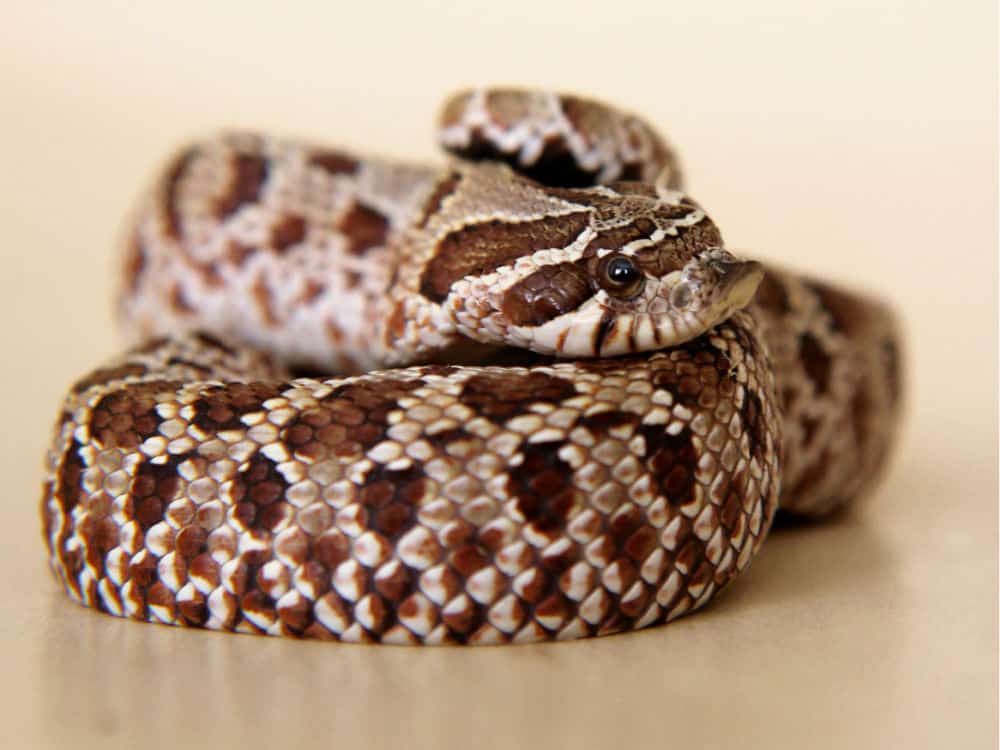
Hognose Diet
In the wild, a hognose snake predominantly eats toads, frogs, mice, lizards, reptile eggs, and occasionally carrion. Captive-bred hognose will readily eat a rodent once a week. The prey item should be the same diameter as the snake’s head.
Hatchling hognose should be fed defrosted pinky mice every five days. You can scent a toad or lizard on the baby snake’s diet if it’s reluctant to feed.
The process involves rubbing and storing the mice with a dead toad or lizard so that the pinky mouse will acquire the specimen’s scent. Do this for a few feeds as you start to wean the hatchling from scented pinky mice.
A full-grown adult hognose snake needs to feed only once in a week or every ten days. A single, appropriately sized rodent is enough to feed the snake. Giant hognose snakes may require two adult mice per feed or large prey items like rats.
Although you can add toads and frogs in the snake’s diet, it may be challenging to come by if your local pet store doesn’t stock them. Besides, it’s a challenge to get them to eat the rodents again once they get hooked.
A hognose snake is an eager eater, as they strike their food quickly from any direction. Therefore, it’s best to use tongs or forceps when feeding your pet. You can feed it in the enclosure, although fancier people prefer to feed in a separate tub to keep the primary enclosure cleaner. Some feel that a separate feeding cage may not be strictly necessary.
When the snake swallows the food, you will notice a lump that can slowly digest within 24 hours. Be careful not to feed the hognose too often or food that is too large as it can cause complications. Also, overfeeding the snake will make it overweight.
Never handle your snake several hours before feeding or right after a feed as it may regurgitate the meal.
Live or Pre-Killed Prey?
Feeding live or pre-killed prey is a question often asked by novice snake keepers and those intending to have a hognose as an additional pet.
There are different viewpoints on the subject, but it’s easier to feed thawed rodents. Just be sure to completely melt the frozen rodent by placing it in warm water several hours before placing it in the snake’s cage.
A thawed mouse is more comfortable to digest. Besides, frozen mice are readily available in most pet store shops. You can buy them in bulk and store them in the freezer.
On the other hand, live rodents carry parasites that can transfer to your snake. Most importantly, it is safer to feed the hognose with a pre-killed prey as a live mouse can bite or injure your snake.
Live prey can also be too active for a younger snake making it challenging to eat. Further, an attack can traumatize your snake.
Does Your Hognose Snake Need Vitamin Supplements?
Although the hognose snake in the wild gets all the nutrients it needs from the animals it eats, the case may not be the same for a captive-bred hognose. Some studies suggest that commercially-bred feeder rodents don’t have all the nutrients that your snake might require.
Therefore, there is a risk that your snake might suffer nutritional deficiency over time. Vitamins supplements and calcium make an excellent addition to the snake’s diet. Lightly dust the prey items with the supplements and give it to your snake.
Water
You will hardly see your hognose drink water; however, it still needs water. Regular clean tap water works well and is safe. Do not use Reptisafe or other water conditioners that claim to remove chlorine. Putting the conditioner in the water is negligible and can be dangerous to the snake’s health.
Keep a sturdy bowl of water in the snake’s enclosure it will drink in the absence of an audience. Also, clean and sanitize the bowl every once a week to prevent bacteria growth and often if the snake fouls the water.
Hognose Handling and Temperament
The hognose is docile and easy to handle. It spots a variety of color phases, patterns, and attractive color morphs ranging from dusty charcoal to coral pink. Due to genetic mutations, the hognose is available in a broader range of colors than ever before.
The hognose is an excellent choice for new and seasoned reptile enthusiasts. The snake has a short build, keeled scales, square blotches, or bars with interspersed white, yellow, or orange colors.
However, they have an impressive array of bluffing behaviors that can intimate a new owner. It features a unique skull, a rostral bone structure, and can flatten out the ribs along its neck to make a “hood” like a cobra when threatened. It also produces a loud hiss and strikes repeatedly at the predator with a closed mouth in forwarding or sideways movement.
Conversely, a baby hognose will play dead and roll over on its back, mouth agape and protrude the tongue as a last resort defense mechanism. In particular, the western hognose will squirt a foul-smelling musk as a final result to ward off danger.
Handling the Hognose and How to Avoid Being Bitten
Before you handle the hognose, wash your hands to rid any unnatural scents so that you can smell like a human. A hand sanitizer is a quick way to get rid of germs and odors and on your hands.
A hognose snake rarely bites out of defense or aggression. However, despite a stocky body, a hognose can strike with surprising speed. Due to their eager feeding habits, hognose snakes can bite their owners from any side – that’s just how a hognose is ready for a meal.
If you are intimidated by these behaviors, you can hook the snake when removing it from its cage. Don’t pick the snake from the front instead, reach around and approach the snake from behind. That way, you will keep your hand from its face. You can also wear gloves for the first few times just in case it gets agitated.
Additionally, avoid touching the top part of your new snake’s head until it knows and trusts you. Once the snake is out of its cage, handle it gently, and the hognose will realize you won’t harm it.
Hold it gently and guide its movement with your hand – it will ease up and begin to explore your arm. Give your new snake a day to settle down before handling. Remember not to handle your snake within the last 48 hours after eating and when it is shedding.
Shedding
Like any other reptile, a hognose snake sheds its skin regularly to maintain the health of scale. An adult hognose sheds its entire skin all at once. On the other hand, hatchlings shed more often than adults as they outgrow their skin faster.
When a hognose snake is in the middle of a shedding cycle, you might notice its skin and eyes are cloudy. Snake keepers refer to the clouding appearance as “going blue.”
The clouding in the eyes limits the snake’s vision, and the best thing you can do is leave it alone to go through the process. Besides, snakes are highly irritable when they are shedding because they cannot see well.
Sometimes, the snake may have issues and not shed properly if the humidity in its environment is not right. Provide a bowl of warm water in the enclosure so that the snake can soak whenever it needs.
Check the snake if it has shed to ensure that the skin is appropriately peeled off, especially around the eyes. If the snake does not peel the skin properly, it could pose serious health problems; thus, you should take it to the veterinarian.
Common Hognose Diseases
You can be worried when your hognose stops to eat and look sickly. However, snakes are good at pretending that all is well. Therefore, you must be extra vigilant to notice any changes with your hognose.
Take note of these tips to help you notice any changes that may indicate a sign of illness:
- Weigh your snake weekly as a sudden change in the weight could be a warning sign of a disease.
- Keep a regular record of the feeding habits, behavior, and shedding.
- Keep a reptile first aid kit handy should your snake get injured.
Blister disease affects the bottom scales of the snake. It is a common disease associated with constant contact with a damp, filthy environment. The symptoms include a reddish appearance on the scutes, and when left untreated, they swell. Call a vet immediately for treatment and ensure that the snake’s environment is kept clean.
Other common conditions are respiratory infections associated with poor husbandry. When the snake stays in an enclosure where it does not receive optimal temperature, the immune system is suppressed, predisposing it to pneumonia. Thus, correct heating combined with sanitation is crucial.
Mouth rot and fungal infection are often a function of dirty environments. You can easily detect mouth rot as pus lined around the mouth or bubbling nostrils. If you notice these symptoms, see the nearest veterinarian immediately for antibiotics.
Salmonella
Contrary to what most people believe, salmonella infection in a hognose snake is infrequent. If you clean and adequately sanitize the snake’s enclosure, you should never have any problem.
However, if you notice any of the above changes, call a veterinarian near you or consult a reptile health expert online.
Conclusion
A hognose snake can make an excellent addition as a pet. Besides, hognose snakes are sold annually by the thousands and pose little or no real threat to their owners. It’s also a delightful ophidian and deserves the best care you can provide.

